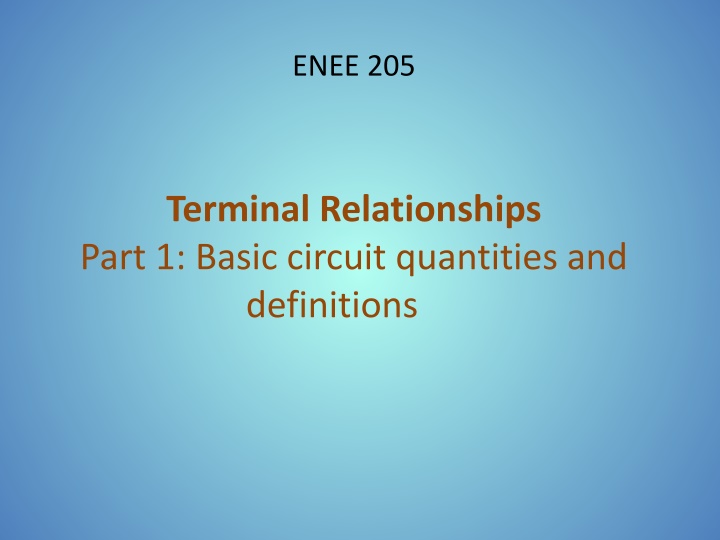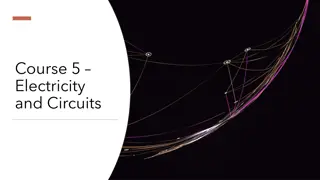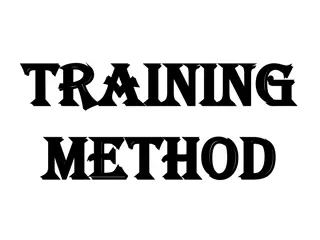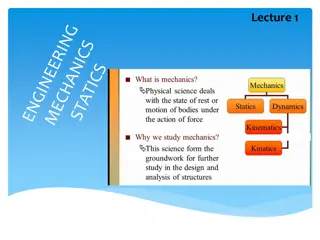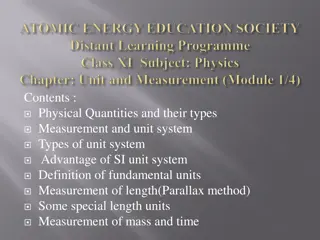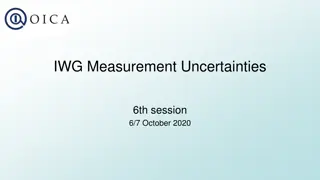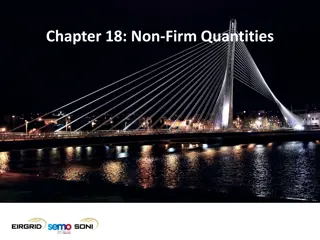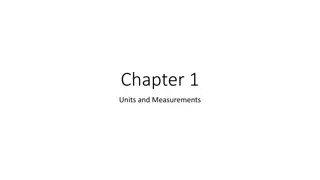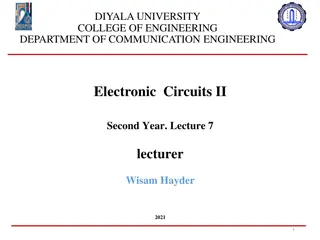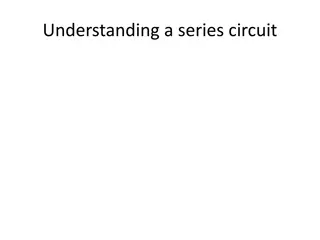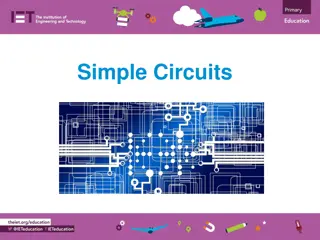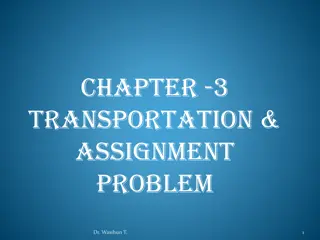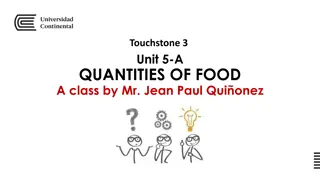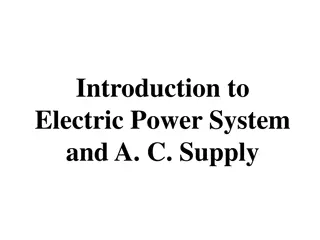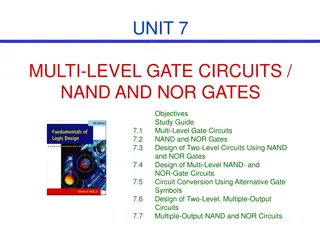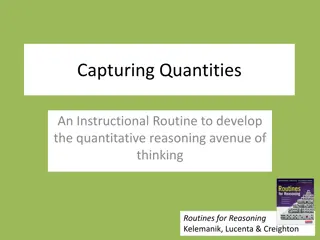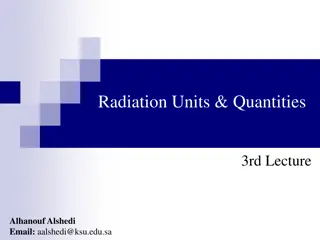Basic Circuit Quantities and Definitions
This content covers fundamental concepts in electrical circuits, including definitions of circuit quantities like charge, current, energy, power, and voltage. It also explains the use of prefixes in circuit measurements, reference directions in terminals, and the distinction between active and passive devices in circuits. Constituent relations for voltage, current, and power in two-terminal devices are discussed, providing a comprehensive overview of introductory circuit theory.
Download Presentation

Please find below an Image/Link to download the presentation.
The content on the website is provided AS IS for your information and personal use only. It may not be sold, licensed, or shared on other websites without obtaining consent from the author.If you encounter any issues during the download, it is possible that the publisher has removed the file from their server.
You are allowed to download the files provided on this website for personal or commercial use, subject to the condition that they are used lawfully. All files are the property of their respective owners.
The content on the website is provided AS IS for your information and personal use only. It may not be sold, licensed, or shared on other websites without obtaining consent from the author.
E N D
Presentation Transcript
ENEE 205 Terminal Relationships Part 1: Basic circuit quantities and definitions
Circuit Quantities Quantity Charge Current Energy Power Voltage Symbol q(t) i(t) U(t) p(t) v(t) Units Coulombs (C) Amperes (A) Joules (J) Watts (W) Volts (V) Electric and Magnetic Fields (not used directly in course)
quantity PREFIXES Circuit quantities can vary over many orders of magnitude, so prefixes are often convenient to use. For example, the charge of one electron is very small: Q= -1.602 x 10-19 C - this could be written as -0.1602 aC, where the a stands for 10-18 The list of prefixes that is most useful for us is: p = pico = 10 -12 n = nano = 10 -9 = micro = 10 -6 m = milli = 10-3 It is o.k. to write a number in any of three ways: 1,234 A = 1.234 kA = 1.234x103 A k = kilo = 10 3 M = mega = 10 6
Reference Directions Terminal: A metal contact on an electric component that is used to connect it to other components in the circuit, usually by attaching a wire to it. Reference Directions: an arbitrarily assigned direction for current or polarity for a voltage that is used to decide if a quantity is positive or negative. For example, if a current is positive, that means it flows in the direction of the arrow on the drawing. If the current is negative, it is actually flowing in the opposite direction.
Active and Passive devices A passive device is one which does not generate electric energy examples are resistors, inductors, capacitors, diodes and transistors. An active device does generate electric energy, converting it from some other form of energy, like batteries or solar cells. We call active devices sources. Passive sign convention: For passive components, we agree to coordinate the voltage and current reference directions, so that the reference current is always entering the positive polarity terminal of the reference voltage (or leaving the negative terminal). For sources, we may or may not use the passive sign convention, so always pay attention to instructions!
Constituent relations Voltage is work per unit charge: v(t) = U(t)/q(t) Current is the time rate of change of charge: i(t) = dq/dt Power is the time rate of change of energy: p(t) = dU/dt For two-terminal devices, power can be shown to be: p(t) = v(t) * i(t) Comments: (1) If you use the passive sign convention, then p(t)>0 means that power is flowing into the component, p(t)<0 means that power is flowing out of the component. (2) We will always look to find currents and voltages in a circuit first, and then use constituent relations to find any other desired circuit quantity.
ENEE 205 Terminal Relationships Part 2: Equations for resistors, inductors, and capacitors
Terminal Relationships A terminal relationship is an equation linking the current entering a component to the voltage across a component. A terminal relationship depends only on the internal properties of a component: its size, shape, and material composition. It does not depend on anything that might be connected to the component. The relationships are for ideal components, so there is always a set of assumptions that need to be true in order for the relationship to hold. In this class, we will assume that our components are always ideal, and therefore almost always the assumptions are automatically satisfied. Terminal relationships will give us one-half of the equations that we need to solve for all voltages and currents in a circuit. The other half will come from Kirchhoff s Laws!
The Resistor Resistors are devices that do not store any energy they only convert electric energy into heat! The symbol for a resistor is shown to the right. The terminal relationship for a resistor is known as Ohm s Law: v(t) = i(t) R This law assumes the passive sign convention was used. R is the Resistance of the resistor and its units are Ohms ( ), where = Volts/Amps. Plugging Ohm s Law into the power equation yields: p(t) = R i(t)2 = v(t)2 / R = G v(t)2 where the conductance G is defined by G=1/R. G has the units of mhos! In addition to the resistance, the amount of power a resistor can dissipate is an important quantity when looking to choose a resistor for an application.
The Capacitor Capacitors are devices that can store electric energy. They store this energy by placing equal but opposite charges on two metal plates separated by a dielectric material (non-conducting material). The symbol for a capacitor is shown to the right. The capacitance C is the ratio of the charge on one plate to the voltage across the plates: C = q(t)/v(t). The capacitance is a constant that depends only on the properties of the capacitor: its size, shape, and material composition. Capacitance has the units of Farads (F) where F = Coulombs / Volts = Amps * seconds / Volts. The terminal relationship is: i(t) = C dv/dt.
Capacitors, part II The power into a capacitor is p(t) = C v(t) dv/dt, which can be positive or negative. The energy stored in a capacitor is U(t) = C v(t)2 / 2. If we only allow finite amounts of power, the voltage across a capacitor must be continuous In addition to the capacitance, the amount of voltage a capacitor can withstand is an important quantity when looking to choose a capacitor for an application.
The Inductor Inductors are devices that can store magnetic energy. They store this energy by running a current through a multi-turn wire, often wound around some magnetic material. The symbol for an inductor is shown to the right. The inductance L is the ratio of the total magnetic flux through the coil surface to the current through the coil: L= (t)/i(t). The inductance is a constant that depends only on the properties of the inductor: its size, shape, and material composition. Inductance has the units of Henries (H) where H = Webers / Amps = Volts * seconds / Amps. The terminal relationship is: v(t) = L di/dt.
Inductors, Part II The power into an inductor is p(t) = L i(t) di/dt, which can be positive or negative. The energy stored in an inductor is U(t) = L i(t)2 / 2. If we only allow finite amounts of power, the current through an inductor must be continuous In addition to the inductance, the amount of current an inductor can carry is an important quantity when looking to choose an inductor for an application.
ENEE 205 Terminal Relationships Part 3: Ideal, Independent Voltage and Current Sources
Ideal Independent Voltage Sources General symbol: DC (constant) voltage source symbol: A voltage source is defined by a specific equation for the time- dependence of the voltage across the two terminals: v(t) = . Voltage sources can be divided into two types: periodic and non- periodic. We will look at both types, but focus on one special periodic voltage source: the AC (sinusoidal) source: v(t) =Vo cos ( t + ). In this formula, is the angular frequency of the oscillation and is the initial phase angle. A DC source has no time dependence: v(t) = Vo. One could think of it as a sinusoidal source with =0. The general symbol for a voltage source is shown in the upper left corner. For a DC course, we can ALSO use the symbol in the upper right corner.
What makes a voltage source ideal and independent? Ideal: The voltage across the source s terminals is given by the equation for v(t) and does NOT depend on the current passing through the source. Independent: The voltage across the source s terminals is given by the equation for v(t) and does NOT depend on any other voltage or current in the circuit to which it is connected. No real voltage source is ideal otherwise one could produce infinite power with infinite current. However, we will use the symbols to represent ideal voltage sources, and when we talk about non-ideal sources later in the course, we will model them as a combination of two components: an ideal voltage source plus some passive component.
Ideal independent current sources General symbol: A current source is defined by a specific equation for the time- dependence of the current through the source: i(t) = . Current sources can be divided into two types: periodic and non- periodic. We will look at both types, but focus on one special periodic current source: the AC (sinusoidal) source: i(t) =Io cos ( t + ). In this formula, is the angular frequency of the oscillation and is the initial phase angle. The general symbol for a current source is shown above. The arrow denotes the direction of the current. There is no separate symbol for a DC current source, one simply uses the general symbol and the formula: i(t) =Io . Interesting Fact: An automatic crossover power supply is one that can function as either a voltage or a current supply.
What makes a current source ideal and independent? Ideal: The current through the source is given by the equation for i(t) and does NOT depend on the voltage across the source. Independent: The current through the source is given by the equation for i(t) and does NOT depend on any other voltage or current in the circuit to which it is connected. No real current source is ideal otherwise one could produce infinite power with infinite voltage. However, we will use the symbols to represent ideal current sources, and when we talk about non-ideal sources later in the course, we will model them as a combination of two components: an ideal current source plus some passive component.
ENEE 205 Terminal Relationships Part 4: Wires, Switches, and Semiconductor Devices
Other common components wire metal used to connect components together there is zero voltage difference between any two points along the same wire, so a wire is like a zero ohm resistor. A zero ohm path is also sometimes called a short. A short has zero voltage across it, but can have any current flowing through it. switch these components have two states open and closed. The figure will indicate in which state they start (in this picture closed) and will also indicate at what time they change to the other state. An ideal switch acts like a short when it is closed, and like an infinite resistance path when it is open. An open has zero current flow but can have any voltage difference across the two terminals.
Semiconductor devices Semiconductor devices are devices who have current flowing through non-metal materials (the semi- conductors) Semi conductor devices act quite differently from devices whose current flows only through metal. As the name implies, there properties are somewhere in between those of metals and insulators. Typical semiconductor materials include: Silicon, germanium, gallium-arsenide, etc. Unlike in metals, the moving charge in semiconductors may be negative OR positive charges (only negative charges electrons move in metals).
Semiconductor devices, part II Pure semiconductors are not usually useful one generally dopes the material with some impurity. Some doping results in p material material where moving positive charges dominate. Other doping results in n material material where moving negative charges dominate. Most semiconductor devices are made with combinations of p and n -type materials.
Semi-conductor devices the diode The diode a diode is formed by joining one p type block with one n type block. This device only allows current to flow in one direction from left to right in the figure below. The symbol for the diode is shown below the block diagram. The arrow part of the symbol indicates the allowed direction for the current. The reference polarity should always be picked as shown. We will consider only IDEAL diodes in this course. An ideal diode acts like an automatic switch. If current tries to flow in the allowed direction, the diode acts like a closed switch (i.e. a short). If one tried to pass current in the opposite direction, the diode would act like an open and vd would become negative with no current flow. The diode is the only nonlinear device we will consider in this course but we will talk about the consequences of that property later.
Semi-conductor devices the transistor Transistors usually operate in one of two modes digital, where transistors are either on or off analog, where transistors act in a linear way. For a Bipolar-Junction (BJT), no current will flow from the collector (C) to the emitter (E), unless some current is injected into the base (B). The collector current is linearly proportional to the base current in the analog regime. For a MOSFET, no current will flow from the source (S) to the drain (D), unless some voltage is applied to the gate (G). The source current is linearly proportional to the gate voltage in the analog regime.
Ideal dependent sources Dependent sources are used to model transistors and combinations of transistors and other components. They come in four varieties: 1. Current-controlled current sources 2. Voltage-controlled current sources 3. Current-controlled voltage sources 4. Voltage-controlled voltage sources There are only two different symbols for dependent sources: There will ALWAYS be an equation given, similar to a terminal relationship, that tells you the dependent source s voltage or current in terms of some other voltage or current in the circuit.
The ideal op-amp The operational amplifier, or op-amp, is a voltage-controlled, voltage source. It s symbol is shown below: The output voltage is proportional to the voltage difference between the inverting and non-inverting terminals. There are three ideal op-amp assumptions: (1) the gain of the op- amp is infinite, (2) the resistance between the two input terminals is infinite, and (3) the output terminal has zero resistance. Important consequences of these ideal assumptions are: (1) no current flows into either input terminal and (2) there is zero voltage difference between the two input terminals. These consequences will be needed to solve op-amp problems later.
ENEE 205 Terminal Relationships Part 5: Sample Problems
Examples of terminal relationships for Resistors, capacitors, and inductors The voltage across a component is v(t) = 10cos(100t) V. Plot the current through the component if it is a (a) 50 resistor, (b) 100 F capacitor, or (c) 20 mH inductor. Calculate the instantaneous power for each component.
Problem Answer for a resistor The voltage across the resistor is v(t) = 10cos(100t) V. The current through the 50 resistor is i(t) = v(t)/50 thus: i(t) = 200cos(100t) mA
Problem Answer for a capacitor The voltage across the capacitor is v(t) = 10cos(100t) V. The current through the 100 F capacitor is i(t) = C dv(t)/dt=10-4x(-1000sin(100t)) A thus: i(t) = -100sin(100t) mA
Problem Answer for an inductor The voltage across the inductor is v(t) = 10cos(100t) V. The current through the 20 mH inductor is ?? ? ??, and let s assume i(0)=0 A i(t) = 1 ? 0 thus: ???? 100? ?? = 5sin 100? ? i(t) = 500 0
Examples of terminal relationships for Resistors, capacitors, and inductors The voltage across a component is v(t) = 5000t V for 0<t< 1ms and Plot the current through the component if it is a (a) 50 resistor, (b) 100 F capacitor, or (c) 20 mH inductor. v(t) = 5 V for t >1 ms
Problem answer for a resistor The voltage across the resistor is v(t) = 5000t V for 0<t< 1ms v(t) = 5 V for t >1 ms and So the current is: i(t) = v(t)/50, thus The current through the resistor is i(t) = 100t A for 0<t< 1ms i(t) = 100 mA for t >1 ms and
Problem answer for a capacitor The voltage across the resistor is v(t) = 5000t V for 0<t< 1ms v(t) = 5 V for t >1 ms and So the current is: i(t) = C dv(t)/dt, thus The current through the resistor is i(t) = 500 mA for 0<t< 1ms i(t) = 0 mA for t >1 ms and
Problem answer for an inductor The voltage across the resistor is v(t) = v(t) = 5000t V for 0<t< 1ms 5 V for t >1 ms and ?? ? ??, and let s assume i(0)=0 A So the current is: i(t) = 1 ? 0 For 0<t< 1ms: ? 5000??? = 250000?2 2= 125?2 ?? ? ? = ? 0 + 50 0 Note that i(1 ms) = 125 mA For t> 1ms: ? ? ? = ? 1 ?? + 50 5?? = 250 ? .001 = (250? .125) ? 1 ??
Examples of terminal relationships for Resistors, capacitors, and inductors A passive component has the following voltage applied across it and the associated current flowing through it. For this voltage - current combination, state whether the component is a resistor, a capacitor or an inductor, and give the corresponding value of resistance, capacitance, or inductance. v(t) = 20t mV i(t)= 10 mA
Problem answer The parameter R, C, or L must be a positive constant: vR(t) = iR(t) R ic(t) = C dvc/dt vL(t) = L diL/dt OR R = vR(t) / iR(t) = 20 t / 10 = 2t (NOT a constant!) C = ic(t) / dvc/dt = 10 / 20 = 0.5 (Positive constant!) L = vL(t) / diL/dt = 20 t / 0 = infinity (Not a number) So the unknown component is a capacitor with C = 0.5 F!
Examples of terminal relationships for Resistors, capacitors, and inductors You are given a mystery box that has some component in it (either R, L or C), and you are asked to find out what type of component it is, and what the component value is. You have a current source that you can connect to the two terminals of the box that has the current dependence (assuming that t=0 is the time that the current source is connected): i(t) = 10-10*exp(-5t) mA You plan to measure the voltage starting at t=0, but just after you connect the source, John phones you to ask what you think about Jasmine. After a minute, you hang up on him and get back to your mystery box. The voltmeter is reading a constant 0V. Can you still figure out what kind of component it is? If so, what is in the box? If not, why not?
Problem answer Terminal relationships: vR(t) = iR(t) R ic(t) = C dvc/dt vL(t) = L diL/dt After just a few seconds, the current sources puts out a constant 10 mA. A resistor would have a constant, nonzero voltage. A capacitor would have a linearly- increasing voltage. The unknown component is an inductor, since a constant current results in zero voltage.
